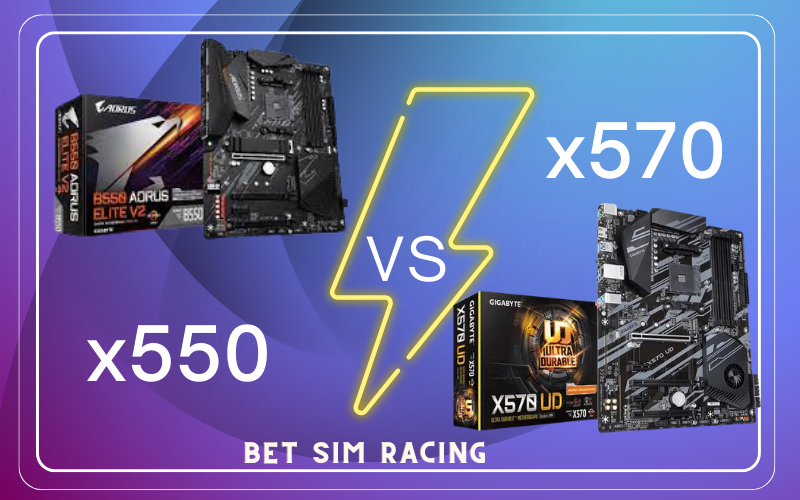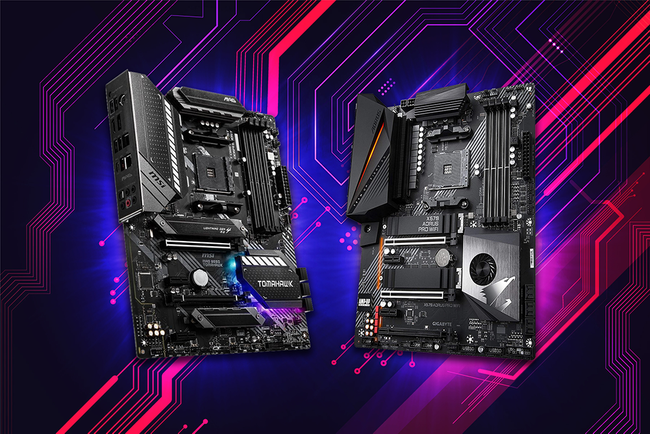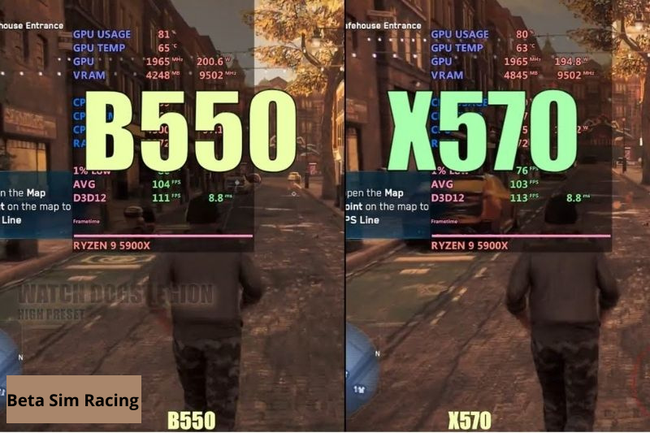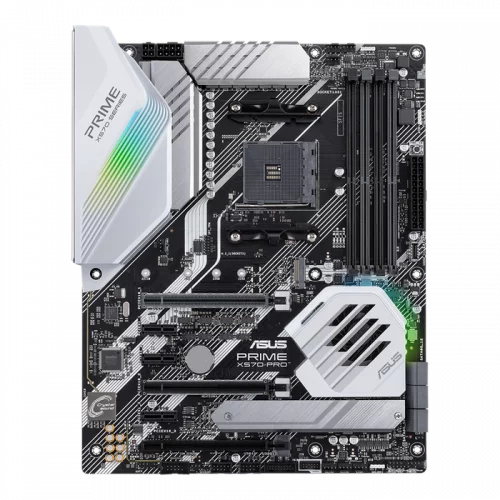For PC builders leveraging AMD’s highly successful AM4 platform, the choice between a B550 and an X570 motherboard remains a critical decision point, While both chipsets support the celebrated Ryzen 5000 series processors, they are engineered for different user needs and budgets. Understanding their fundamental technical differences is the first step in selecting the ideal foundation for your system.
This guide provides an objective, purely informational breakdown of the B550 and X570 chipsets. We will explore the core specifications, connectivity differences, and performance implications, followed by a detailed look at several popular motherboard models from each category. The goal is to equip you with the knowledge to make a confident and informed decision without persuasive language, focusing solely on the facts. For those considering a new build or an upgrade, knowing when you should upgrade your motherboard can provide valuable context.

B550 vs. X570: Head-to-Head Chipset Comparison (2025)
To understand these two platforms, a direct comparison of their core specifications is essential. The table below outlines the primary features of the AMD X570 and B550 chipsets.
| Feature | AMD X570 Chipset | AMD B550 Chipset |
| Platform | AM4 | AM4 |
| Supported CPU Series | Ryzen 2000, 3000, 4000G, 5000 | Ryzen 3000 (G-series excluded), 4000G, 5000 |
| CPU to Chipset Uplink | PCIe 4.0 x4 | PCIe 3.0 x4 |
| PCIe Lanes from CPU | 24 Lanes (PCIe 4.0) | 24 Lanes (PCIe 4.0) |
| PCIe Lanes from Chipset | Up to 16 General Purpose Lanes (PCIe 4.0) | Up to 10 General Purpose Lanes (PCIe 3.0) |
| Overclocking Support | Yes (CPU & Memory) | Yes (CPU & Memory) |
| Max Native USB 3.2 Gen2 | Up to 8 Ports | Up to 2 Ports |
| Max Native SATA III Ports | Up to 12 Ports (4 from chipset) | Up to 6 Ports (4 from chipset) |
| Multi-GPU Support | Yes (NVIDIA SLI / AMD CrossFire) | Yes (AMD CrossFire Only) |
| Typical Form Factors | ATX, E-ATX, Micro-ATX | ATX, Micro-ATX, Mini-ITX |
| Common Cooling Method | Active (Chipset Fan) or Passive (X570S) | Passive (Heatsink) |
Core Differences Explained: PCIe, CPU Support, and Connectivity
While the table provides a high-level overview, the practical implications of these specifications are what truly matter for a build. The decision between B550 and X570 often comes down to how you intend to use your PC’s expansion capabilities.

PCIe Generation: The Key Distinction
The most significant difference lies in the PCIe generation supported by the chipset itself.
- X570: This was the first mainstream chipset to introduce PCIe 4.0 support not only from the CPU but also for its general-purpose lanes. This means that devices connected through the chipset, such as a second or third M.2 NVMe SSD or other expansion cards, can also operate at PCIe 4.0 speeds.
- B550: A B550 motherboard provides PCIe 4.0 support directly from the CPU. This is used for the primary graphics card slot (x16) and typically one M.2 NVMe slot. However, the general-purpose lanes provided by the B550 chipset itself are PCIe 3.0.
Key Takeaway: If you plan to run a single GPU and a single ultra-fast Gen4 NVMe SSD, a B550 motherboard provides the necessary bandwidth. An X570 is only necessary if you require multiple PCIe 4.0 NVMe SSDs or other high-bandwidth PCIe 4.0 expansion cards.
Chipset Uplink and Downstream Lanes
The connection between the CPU and the chipset (the uplink) also differs. The X570 uses a PCIe 4.0 x4 link, while the B550 uses a PCIe 3.0 x4 link. The X570’s faster uplink provides double the bandwidth, which is necessary to handle the greater number of high-speed devices and PCIe 4.0 lanes it supports downstream. Knowing how many PCIe slots you need is crucial when weighing these options.
CPU Compatibility: A Clear Divide
While both chipsets are on the AM4 socket, their CPU support lists are not identical.

- X570 motherboards generally support AMD Ryzen 2000, 3000, 4000G, and 5000 series CPUs, offering the broadest compatibility on the AM4 platform (with the appropriate BIOS update).
- B550 motherboards officially support only the later generation Ryzen 3000 series (excluding the 3200G and 3400G APUs), 4000G-series, and the full Ryzen 5000 series. They do not support Ryzen 2000 or older CPUs.
Overclocking Support and Power Delivery
Both B550 and X570 chipsets officially support CPU and memory overclocking. The actual overclocking capability of a specific board, however, depends less on the chipset and more on the motherboard’s Voltage Regulator Module (VRM) design and cooling. Premium B550 boards can outperform entry-level X570 boards in this regard. Whether you need a good motherboard for gaming often comes down to these power delivery features for stable performance.
USB and SATA Connectivity
Natively, the X570 chipset offers a more robust I/O configuration. It can provide up to 8 high-speed USB 3.2 Gen2 (10Gbps) ports, whereas the B550 chipset natively supports only 2. Motherboard manufacturers can add more ports using third-party controllers, but the native support is stronger on X570. Both chipsets offer a similar number of native SATA ports. Understanding your connectivity needs, including internal connections like what USB headers are, is important.
Chipset Cooling: Active Fan vs. Passive Heatsink
Due to the higher power draw required to run its PCIe 4.0 lanes, most X570 motherboards feature a small chipset fan for active cooling. While generally reliable, this is another moving part that can be a point of noise and potential failure. In response, manufacturers later released “X570S” boards with larger, passive heatsinks. In contrast, all B550 chipsets are passively cooled, making for a simpler and quieter design.
A Closer Look at Popular X570 Motherboard Models
To illustrate the features available, here is an objective analysis of several specific X570 models.
Asus TUF Gaming X570-Plus (Wi-Fi)
- Form Factor: ATX
- Current Status: This board remains a popular and widely available mid-range option, valued for its balanced feature set.
- Key Specifications: Features a solid 12+2 Dr. MOS power stage design suitable for most Ryzen CPUs. It includes two M.2 slots (one Gen4, one Gen3/SATA), ample USB ports, and integrated Wi-Fi 6. It utilizes an active chipset fan.
Gigabyte X570 Aorus Master
- Form Factor: ATX
- Current Status: A high-end board that is still available. Note that a newer “X570S Aorus Master” exists with a passive, fanless chipset cooler, which is a significant update.
- Key Specifications: This board is built for enthusiasts, with a powerful 16-phase VRM. It features three M.2 slots, all of which are PCIe 4.0 capable. It also includes advanced thermal guards, Wi-Fi 6, and premium audio.
ASRock X570M Pro4
- Form Factor: Micro-ATX
- Current Status: One of the few and most popular Micro-ATX X570 boards, it remains a solid choice for smaller, yet powerful, builds.
- Key Specifications: It provides a 10-phase power design, two M.2 slots (one Gen4, one Gen3/SATA), and a good selection of rear I/O. Its smaller size makes it a niche but valuable option for those who need X570 features in a compact build. Comparing form factors like Micro-ATX vs Mini-ITX vs ATX can help put its size in perspective.
Gigabyte X570 Aorus Ultra
- Form Factor: ATX
- Current Status: Positioned between the Pro and Master models, the Aorus Ultra is a strong upper-mid-range contender that is still available.
- Key Specifications: It features a 12+2 phase VRM with high-quality power stages. It’s equipped with three M.2 slots (all with thermal guards), Wi-Fi 6, and a comprehensive rear I/O panel.
MSI MEG X570 Godlike
- Form Factor: E-ATX (Extended ATX)
- Current Status: This is an enthusiast-class, “halo” product. While still available, it represents the highest end of the AM4 platform and carries a premium price tag.
- Key Specifications: Engineered for extreme overclocking with a 14+4+1 phase VRM. It includes three M.2 slots, a bundled M.2 XPANDER-Z Gen4 card for two additional NVMe drives, 10G Super LAN, Wi-Fi 6, and an OLED dynamic dashboard.
A Closer Look at Popular B550 Motherboard Models
Here is a parallel analysis of several B550 models, showcasing the value and features available on this platform.
Gigabyte B550M DS3H
- Form Factor: Micro-ATX
- Current Status: A highly popular entry-level board that offers an accessible entry point to the B550 chipset and Ryzen 5000 support.
- Key Specifications: Features a modest 5+3 phase digital VRM, suitable for 6-core and some 8-core Ryzen CPUs. It includes two M.2 slots (one Gen4, one Gen3) and a basic but functional set of ports.
MSI MAG B550 Tomahawk
- Form Factor: ATX
- Current Status: One of the most recognized and well-regarded mid-range motherboards. The “MAX WIFI” version is also very common.
- Key Specifications: Equipped with a strong 10+2+1 phase VRM that can comfortably handle high-core-count CPUs. It offers two M.2 slots (one Gen4, one Gen3), 2.5G LAN, and a robust heatsink design.
Gigabyte B550M Aorus Pro
- Form Factor: Micro-ATX
- Current Status: A very strong mid-range Micro-ATX option, often available as the “Pro-P” or “Pro-AX” (with Wi-Fi).
- Key Specifications: Features a 10+2 phase digital VRM with excellent thermal performance for its class. It includes two M.2 slots, 2.5GbE LAN, and a pre-installed I/O shield, features typically found on more expensive boards.
ASUS ROG Strix B550-F Gaming
- Form Factor: ATX
- Current Status: A direct competitor to the MSI Tomahawk, this is a staple in the mid-to-high-end B550 market.
- Key Specifications: It boasts a 12+2 power stage design, two M.2 slots (both with heatsinks), 2.5G LAN, and high-quality audio. It’s known for its premium aesthetics and a strong BIOS. For setup, knowing how to enter the motherboard BIOS is a useful skill.
Gigabyte B550 Aorus Master
- Form Factor: ATX
- Current Status: A premium B550 board designed to compete with entry-level X570s. It is still available for users seeking maximum features on the B550 platform.
- Key Specifications: This board stands out with an exceptional 16-phase VRM and three M.2 slots (one Gen4, two Gen3). It includes extensive heatsinking, Wi-Fi 6, and a feature set that blurs the lines between the B550 and X570 platforms.
Gigabyte B550 Vision D
- Form Factor: ATX
- Current Status: A unique, creator-focused motherboard. The “Vision D-P” is a slightly revised and more current model.
- Key Specifications: Its defining feature is integrated Titan Ridge Thunderbolt 3 support, offering two USB-C ports with 40Gbps bandwidth. It has a capable 12+2 phase VRM, Wi-Fi 6, and a distinct white and silver aesthetic. This is an ideal board for content creators who need high-speed external connectivity.
Deciding in 2025: Is B550 or X570 the Right Choice?

Your choice ultimately depends on your specific requirements for connectivity and expansion.
Scenarios Favoring an X570 Motherboard
- Multiple PCIe Gen4 Devices: You plan to install two or more PCIe 4.0 NVMe SSDs and require them all to run at maximum speed.
- Maximum I/O Connectivity: Your workflow depends on having a large number of high-speed USB 3.2 Gen2 ports directly from the chipset.
- Older CPU Support: You have a Ryzen 2000-series CPU that you plan to use before a potential future upgrade.
Scenarios Favoring a B550 Motherboard
- Mainstream Gaming and General Use: Your build will consist of a single GPU and a single PCIe 4.0 NVMe SSD. This covers the vast majority of gaming and productivity PCs.
- Budget-Conscious Builds: B550 motherboards generally offer a better price-to-performance ratio for most users, allowing funds to be allocated to other components like the CPU or GPU.
- Silent Operation: You prefer a completely silent, passively cooled chipset without a fan.
- Compact Builds: The B550 chipset is more prevalent in the Mini-ITX form factor, making it the default choice for many small form factor (SFF) PCs.
Frequently Asked Questions (FAQ)
Is X570 still a good choice?
For a specific niche of power users who require multiple PCIe 4.0 slots for NVMe RAID arrays or other high-bandwidth cards, X570 is still relevant. However, for the majority of users, including most gamers, a quality B550 motherboard provides all necessary features for less cost.
Will I lose gaming performance by choosing B550 over X570?
No. Since the primary graphics card slot on both B550 and X570 boards connects directly to the CPU using the same PCIe 4.0 x16 interface, there is no difference in gaming performance between the two chipsets, assuming all other system components are equal.
Can a B550 motherboard handle a powerful CPU like the Ryzen 9 5950X?
Absolutely. High-quality B550 motherboards (like the MSI Tomahawk or Gigabyte Aorus Master) are equipped with robust VRMs and cooling solutions that are more than capable of handling the power delivery requirements of the 16-core Ryzen 9 5950X, including overclocking.
What is the lifespan of an AM4 motherboard?
The physical lifespan of a motherboard can be very long, often outlasting its practical relevance. The AM4 platform is mature, meaning no new CPU generations will be released for it. However, its support for the powerful Ryzen 5000 series ensures it will remain a viable and powerful platform for gaming and productivity for many years to come. Thinking about how long a motherboard lasts involves considering both physical durability and technological relevance.
Do all X570 motherboards have a chipset fan?
Most of the original X570 motherboards do. However, manufacturers later introduced “X570S” models (with the ‘S’ standing for ‘Silent’), which feature larger, fanless passive heatsinks to cool the chipset.
Final Analysis: Choosing the Right Foundation for Your PC
The B550 vs. X570 debate is a clear illustration of targeted product design. The X570 chipset was built to be the enthusiast’s choice, offering comprehensive PCIe 4.0 support across the board for users with extreme expansion needs. The B550 chipset, arriving later, offered a more pragmatic solution for the mainstream market. It intelligently provides the key feature—PCIe 4.0 for the GPU and primary SSD—while cutting back on the less-utilized chipset-based Gen4 lanes to reduce cost and complexity.
For a new AM4 build, a B550 motherboard is the logical choice for over 95% of users. It provides the essential modern features, robust power delivery on mid-to-high-end models, and better overall value. An X570 motherboard should only be considered by those with a verified, specific need for multiple PCIe 4.0 NVMe drives or the extensive native I/O that the chipset provides.

Holding a Ph.D. in Computer Science, Dr. Alistair Finch is our chief PC Component Benchmark Analyst. He provides meticulous, data-driven analysis of CPUs and GPUs, moving beyond marketing claims to reveal their true performance. His guides help readers understand the intricate relationship between hardware architecture and real-world gaming frame rates.
